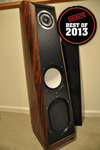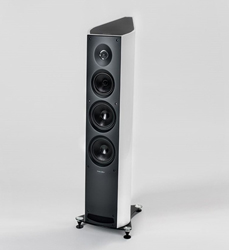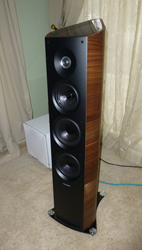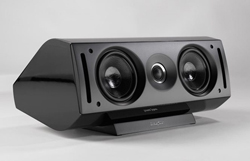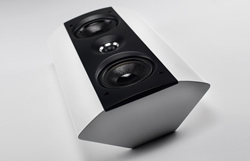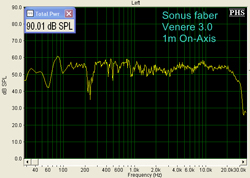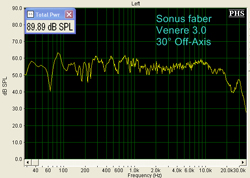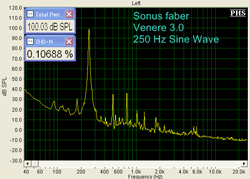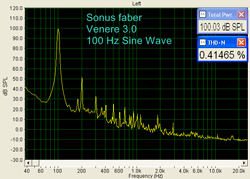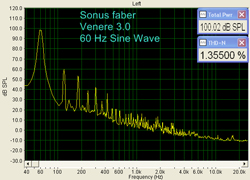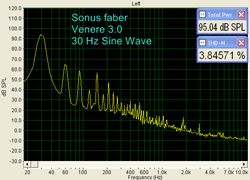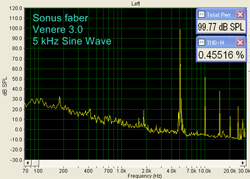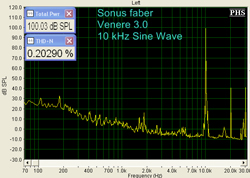Introduction to the Sonus faber Venere 3.0 Speaker System
This Sonus faber home theater speaker system is based on the new Venere 3.0 floor standing speakers, the flagship of the Venere line. The Veneres are designed in Italy and include drivers designed from the ground up specifically for this speaker line. The drivers are made exclusively for Sonus faber by some of the best suppliers on the planet. The Veneres even have the famous Sonus faber lyre-shaped cabinets.
What sets them apart, however, is that they are assembled in China which means they are available at a surprisingly affordable price. That means you can get a system with a bona fide high end pedigree which offers a taste of the Sonus Faber line at a very attainable price point.
This system also included Venere’s Center and Wall models with a REL T9 thrown in to handle the low bass making for a complete 5.1 system with great promise.
SONUS FABER VENERE 3.0 SURROUND SYSTEM SPECIFICATIONS
Mains | Venere 3.0
- Design: 3.5-way Floor-standing, Ported
- Drivers: One 1.1″ Fabric Dome Tweeter, One 6″ Polypropylene Midrange, Two 7″ Woofers
- MFR: 38 Hz – 25 kHz
- Power Handling: 300 W
- Sensitivity: 90 dB
- Nominal Impedance: 6 Ohms
- Crossover Frequencies: 180 Hz, 220 Hz and 2.3 kHz
- Dimensions: 45.6″ H x 13.4″ W x 17.3 D
- Weight: 47 Pounds/each
- Finishes: Black or White High Gloss Lacquer, Walnut Wood optional
- MSRP: $3,498/pair USD; $3,998/pair – Walnut Wood
- Sonus Faber
Center | Venere Center
- Design: 2-way, Ported
- Drivers: One 1.1″ Fabric Cone, Two 6″ Mid/Woofers
- MFR: 60 Hz – 25 kHz
- Power Handling: 150 W
- Sensitivity: 89 dB
- Nominal Impedance: 6 Ohms
- Crossover Frequency: 1.8 kHz
- Dimensions: 8.8″ H x 19.7″ W x 11.5″ D
- Weight: 21 Pounds/each
- Finishes: Black or White High Gloss Lacquer, Walnut Wood Optional
- MSRP: $798/each USD; $898/each – Walnut Wood
- Sonus Faber
Surrounds | Verus Forte Satellite
- Design: 2-way Wall Mount, Sealed Enclosure
- Drivers: One 1.1″ Fabric Dome Tweeter, Two 6″ Mid/Woofers (One Active, One Passive)
- MFR: 50 Hz-25 kHz
- Power Handling: 150 W
- Sensitivity: 87dB
- Nominal Impedance: 6 Ohms
- Crossover Frequency: 2.0 kHz
- Dimensions: 19.7″ H x 11.5″ W x 6.7″ D
- Weight: 13.8 Pounds/each
- Finishes: Black or White High Gloss Lacquer, Walnut Wood Optional
- MSRP: $698/each USD; $798/each – Walnut Wood
- Sonus Faber
Subwoofer | REL T-9
- Design: Down-firing Active Driver, Front-firing Passive Radiator, Ported
- Drivers: Two 10″, One Active, One Passive
- Amplifier: 300 Watts RMS (Class AB)
- MFR: 28 Hz at -6 dB In-room
- Inputs: Hi-Level Neutrik Speakon, Low-Level Mono RCA, LFE RCA
- Outputs: None
- Weight: 39 Pounds
- Dimensions” 14.75″ H x 13″ W x 14.75″ D
- Finishes: Gloss Piano Black or White Lacquer
- MSRP: $1,599 USD
- REL
- SECRETS Tags: Sonus faber, Speakers, Home Theater, Surround Sound, Audio
Design and Setup of the Sonus faber Venere 3.0 Speaker System
The most fundamental design goal for the Venere’s was an engaging, airy and detailed sound that would be suitable for all types of music and all kinds of users. That sounds like a pretty good mission statement to me!
Sonus faber also wanted the Venere speakers to be easy to incorporate into your listening environment. The Veneres are simple to set up, have excellent dispersion characteristics and the ported models have ports that fire out of the front baffle to reduce boundary effects from the rear wall.
The most obvious outward trait of these speakers is their striking looks. First of all, the internally-braced cabinets are lyre-shaped in keeping with a common Sonus faber characteristic. And the top plates are slanted downward from the rear to the front. So these cabinets are without parallel walls. This not only prevents strong internal resonances, it also improves the structural rigidity of the cabinets.
The main speakers also have tilted baffles to time-align all the drivers. The baffles are curved to avoid off-axis diffraction effects. The top is tempered glass with the Sonus faber logo silkscreened on. The base plate is also tempered glass with adjustable aluminum feet included.
All drivers are designed by Sonus faber in their lab and are made to spec by their suppliers who are among the best in the world.
The largish tweeter is a 29 mm silk dome that was scintillating to listen to and tested very well in my bench testing routine. This driver crosses over at 2.3 kHz to a 6″ polypropylene textile midrange with an aluminum phase plug. The midrange and the two 7″ woofers all have proprietary “Curv” cone cross sections. Speaking of the woofers, the 3.0 is actually a 3-1/2 way design. (Which raises the question; why not call them the Venere 3.5’s?) In any case, the top woofer operates in the range of 180 – 220 Hz while the lower woofer extends down to a claimed roll off of 38 Hz (which was supported by my bench test results; ~34 Hz in-room).
There are curved guides around the all the drivers that creates a slight horn shape which contributes to an even more vivid and engaging sound. No details were provided regarding the crossovers except this, “Crossover designed to promote a clean signal path and thus the musicality”.
The Venere Center has three active drivers, a 29 mm silk dome tweeter that crosses over to a pair of 6″ Curv cone mids at 1.8 kHz. This speaker also has a lyre-shaped cabinet and comes with a heavy rubber base that allows the speaker to be placed either above or below your screen and then tilted to fire at the listening position. It is front ported via two slots, one on each outer edge of the cabinet.
I used the Venere Walls as the rear speakers in a 5.1 set up. These are also a bass reflex design but with one active main driver while the other driver is a passive radiator. These speakers come with a unique mounting scheme as far as home speakers are concerned. It operates much like a typical outdoor speaker. You mount a bracket to the back of the speaker and one to the wall then these get bolted together. So the speaker can swivel on its longer axis, but that’s it – just panning, no tilt or azimuth control. My only real complaint with this system related to the wood screws that you must drive into the speaker cabinets – I would much prefer threaded inserts.
All the Venere models were equipped with magnetically attached grills. They are available in gloss black, gloss white or a gorgeous real walnut finish. I wound up getting real wood mains and a glossy black center and rears. They all were serious eye candy, but I was most taken by the real wood; it’s like tiger’s eye in that it shimmers in the light and has an uncanny depth in the grain.
All in all, the Venere speakers exhibited a remarkable degree of refinement in their build quality, particularly considering their price point. I’m not sure how it is possible to produce speakers with all the physical qualities of these babies and keep them at such an accessible price.
I also got a REL T9 subwoofer to go with this review set. I will be writing up a full review on this subwoofer in a separate article. But let me just say that this little sub was one mighty impressive little piece of audio engineering in its own right.
I placed all speakers in the usual locations around my theater space. I mounted the Walls on the Walls. The Center was actually a little too wide to fit on the shelf below my screen so I had to invert the shelving which placed it about 3″ lower than where I typically have my center speaker. But that was OK as I was able to tilt it up on the rubber stand so it fired unrestricted toward my ears.
With the mains, I placed them on either side of my projection screen as usual and eventually settled on having them aimed not directly at me, but a little off to sides to where they were basically about 10 degrees off-axis.
I drove the main speakers with a Krell S550i integrated amp set to theater bypass throughout most of the review period. I wanted to mention this here because I connected the REL sub to the speaker terminals as recommended by REL. I tried the unbalanced LFE input at first and then tried the connection off the speaker terminals. I much preferred the second connection method. Can I explain why? Not really. REL says that it passes the sound of your power amp to the sub but I’m not sure that’s it. Let’s just suffice it to say that I was able to get a substantially better blend between the Venere 3.0’s and the sub by using the speaker outs. Mind you, the difference was not subtle nor was it insignificant.
The Sonus faber Venere 3.0 Speaker System In Use
My immediate impression of the Venere system was one of a vivid realism. This was not a realism borne from a rigid chromatic truth as one might expect. These speakers are not exactingly flat. But they do offer a vibrant realism via a clean, dynamic, quick and open sound that I found to be most pleasing and addictive.
I also didn’t feel that the Venere 3.0’s extended as deeply from a subjective standpoint as the bench tests would later reveal, so I gladly bolstered the system’s output by dialing in a crossover of around 60 Hz on the REL T9. This gave the best apparent blend and then I was off to the races!
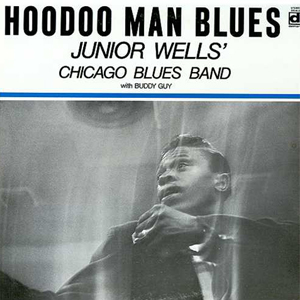
I kicked things off with Junior Wells “Hoodo Man Blues” on vinyl. I listened to this record in 2.1 through a Krell S550i integrated amplifier with the REL sub connected to the speaker terminals. I was hanging out at the house by myself that day and it was sounding so good that I kept turning it up. This record has a little prominence in the lower treble that isn’t neutral but added to the excitement while keeping me from really testing the limits of this system.
This album brought out the vivid midrange qualities I discussed above but also highlighted another great strength of these speakers – a rock solid soundstage. With lesser speakers, location cues of instruments sometimes wander aimlessly as the pitch changes. Not with the Venere 3.0’s. These speakers rendered some of the most solid imagery I have ever heard, even as the pitch changed. This must be due to excellent component matching.
The Venere 3.0’s set the mood on this album through the mournful sound of the harp playing while special mention is due to the fine fabric dome tweeters – cymbals throughout were clean and clear with no “splashy” quality.

The 5-channel Venere system was pretty amazing in its own right with surround music as well. I found the system capable of rendering excellent ambience on live recordings. A great example was the 5.1 DTS HD Master track on John Scoefield “The Paris Concert” Blu Ray. If it weren’t for the soft picture quality on this disc, I’d have felt as if I had just strolled into the venue myself; this being due in large part to the excellent on-wall rears.
At the front of the stage, I was at first concerned there would be an apparent miss-match since white noise sounded different between the center and mains during calibration (with the center sounding much brighter). But in practice I never heard any imbalance across the three front speakers during the evaluation period. And the imagery front to back maintained an eerie solidity as well.
Elsewhere on the Paris Concert disc, I particularly enjoyed Bill Stewart’s flourishes on drums. The attack was clean but not overly forceful or contrived sounding. Scoefield’s guitar work on “Slinky” was mesmerizing – he can make his instrument talk in special ways. And faster tempo songs like “Steeplechase” brought out the best in the Venere system. The notes on lesser systems might smear or bleed together. Not with the Venere’s, each note was an individual entity with its own stately province.

Another fun surround disc is the multichannel SACD of Billy Joel’s “The Stranger”. I used to have the original vinyl of this album, but it is another one that just sort of disappeared when I was in college. So I was delighted when it was rereleased on SACD. On the Venere system, it was quite possibly the best I’ve heard it in years, epic actually.
The sax was raspy and engaging as it should be. Billy Joel’s voice was a tiny bit thin and lacking in weight. On the closing ballad, “Everybody Has a Dream”, the bass was full offering a substantial foundation. The other registers were low distortion creating an opportunity where I could pick out every instrument and voice in the chorus.
All in all, there was a solid foundation in the bass, maybe a tad forwardness in the lower treble but the mids were spectacular. The frequency balance was inevitably different from what I remember on the old system I had when this album first came out. But now the dynamics were even more telling with greater bass punch and extension! And I could have just as much fun as ever listening to this classic recording. (Note to self, discretely check brother’s vinyl collection the next chance you get.)

Now on to a few Blu Ray movies. I started off with “World War Z”. This movie has powerful action sequences right from the start and never really lets up until the closing credits as conveyed via the complex sounds of a sudden and chaotic degradation of society. Even though this movie was bombastic, it was in the details of the quieter moments where the strengths of this system were revealed as a sort of electrostatic transparency.
The little REL T9 never sounded limited so long as the sub’s level was in balance with the mains. The low bass effects were felt as well as heard particularly on the plane crash where this system really rocked! I will have more to say about the REL sub in a separate review in the coming weeks.

I closed out my evaluation of the Venere surround and cinema system with the “Secretariat” Blu Ray. This is a high quality production with incredible production values. This includes not only the colorful and dynamic picture but also the amazing, original music and rich sound mix. These qualities are well preserved by a quality transfer to disc.
Once again, my sense of a vivid realism is the calling card of this speaker system. On “Secretariat”, this was heard through the dialog channel. But also this 5.1 mix was shown in its best light by the Venere system with strong environmental surround activity including rain, thunder, echoes and every other manner of naturally-occurring sounds. Even the sound of the coin toss (which was definitely “enhanced”) had an ethereal quality that I felt on the Veneres.
Two big reasons I picked this movie to review are the music and the pounding hooves of the race sequences. I was not disappointed on either count. And the REL T9 was no fading lily, holding up its end without complaint.
But, once again, this system did not bend sounds with frequency and rendered a rock solid sound field at all times. It was a mesmerizing performance.
The Sonus faber Venere 3.0 Speaker System On The Bench
All below measurements are in-room response. The frequency response tests were performed at 1-meter, the distortion measurements were on-axis near field measurements with the mic tip precisely 1′ from the driver under test.
The on-axis frequency response shows a classic floor bounce suckout between 200 – 250 Hz as would be expected based on the set up. The treble is nicely extended to about 25 kHz. There is a slight prominence in the bass from 70 – 100 Hz. There is strong bass extension to about 34 -35 Hz.
The off-axis response starts rolling off gradually above 10 kHz while the floor bounce is less prominent. This plot demonstrates a choppier response due to other boundary effects though.
The 1 kHz tone was produced by the midrange driver and there was just 0.16% THD+N at 100 dB.
The distortion reading dropped to 0.11% at 100 dB and 250 Hz.
At 100 Hz and 100 dB, the THD + N remained quite low at just 0.41%.
Still pumping out 100 dB at 60 Hz, the Venere 3.0’s kept the distortion at inaudible levels (1.36%).
At 30 Hz and 95 dB, the Venere’s lit up the scope with harmonics, but the measured value was still quite low at just 3.85%. The distortion rose rapidly when I raised the volume or lowered the frequency from here but this is a solid test measurement for these modest sized speakers.
The 5 kHz plot was quite clean and the THD + N at 100 dB was just 0.46%.
At 10 kHz and 100 dB, the Venere tweeter measures 0.20% THD + N. This is one of the cleanest responses I have measured from a conventional dome tweeter at a 100 dB SPL.
Conclusions about the Sonus faber Venere 3.0 Speaker System
I enjoyed every minute of my time with the Venere 3.0 speaker package. This most excellent system was easy to set up, meeting the designers’ goal of flexible placement options. The speakers are beautiful to look at and to listen to as well. The REL T9 subwoofer surpassed my expectations in every possible way. It reminds me that you can’t just look at the specs when buying speakers, you have to experience them first hand to discover their true qualities.
My final evaluation is that the Venere system has a remarkable precision that lends itself to superior imaging, a super solid stage up front with fine ambience in the front to back dimension. Its most telling strength is a realism, a vivid sound that is borne from a passionate sense for music and cinema. Great bench tests results demonstrate a low distortion design that is certainly a major part of the engaging sound I experienced. This is a system that is easy to live with and easy to love with.


